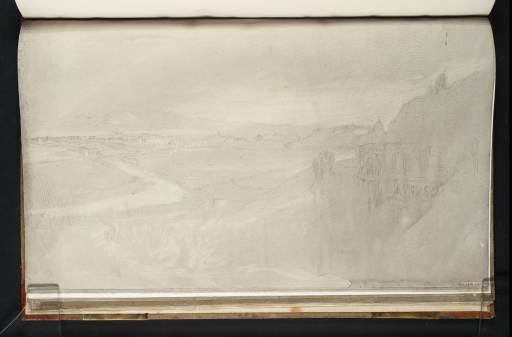Joseph Mallord William Turner View of Rome from Villa Madama on Monte Mario 1819
Image 1 of 2
Joseph Mallord William Turner,
View of Rome from Villa Madama on Monte Mario
1819
Joseph Mallord William Turner 1775–1851
Folio 48 Recto:
View of Rome from Villa Madama on Monte Mario 1819
D16377
Turner Bequest CLXXXIX 48
Turner Bequest CLXXXIX 48
Pencil and grey watercolour wash on white wove ‘Valleyfield’ paper, 229 x 368 mm
Stamped in black ‘CLXXXIX 48’ bottom right
Stamped in black ‘CLXXXIX 48’ bottom right
Accepted by the nation as part of the Turner Bequest 1856
Exhibition history
1878
[Oxford Loan Collection], University of Oxford, 1878–1916 (105 and 24).
References
1878
Catalogue of Sketches by Turner Lent by The Trustees of the National Gallery to the Ruskin Drawing School, Oxford, London 1878, nos.105 (1st edition), 24 (2nd edition), as ‘From Monte Mario’.
1904
E.T. Cook and Alexander Wedderburn (eds.), Library Edition: The Works of John Ruskin: Volume XIII: Turner: The Harbours of England; Catalogues and Notes, London 1904, no.24, p.562, as ‘Rome. The City from the Vatican’.
1909
A.J. Finberg, A Complete Inventory of the Drawings of the Turner Bequest, London 1909, vol.I, p.563, (as ‘Rome, from the Vatican. Oxford, 105–24.’).
1984
Cecilia Powell, ‘Turner on Classic Ground: His Visits to Central and Southern Italy and Related Paintings and Drawings’, unpublished Ph.D thesis, Courtauld Institute of Art, University of London 1984, p.427, as ‘Rome from near Villa Madama’.
Some of the most famous panoramas of Rome could be seen from the heights of Monte Mario, a hill to the north of the city (for a general discussion see Tate D16174; Turner Bequest CLXXXVIII 9a). This sketch depicts a sweeping view of approximately ninety degrees looking south-east from the Esquiline Hill on the left to St Peter’s on the right. Identifiable landmarks visible across the horizon include, from left to right: the obelisk of Piazza dell’Esquilino framed by the Church of Santa Maria Maggiore; the long stretch of the Quirinal Palace; the Capitoline Hill; the Castel Sant’Angelo; the Janiculum Hill; and on the far right, the dome of St Peter’s. The building in the right-hand foreground is the Villa Madama, a sixteenth-century estate built for the Medici family on the eastern slopes of the hill. Turner recorded similar viewpoints on folio 57 (D16388) and within the St Peter’s sketchbook (see Tate D16178–D16181; Turner Bequest 11a–13). He also made several alternative images featuring the view from Monte Mario within this sketchbook, see folios 31, 33 and 60 (D16357, D16360, D16391) and loose sheets (D16337, D16342, D16350, D16352; CLXXXIX 11, 16, 24, 26).
As Cecilia Powell has discussed, the visual approach of depicting a distant prospect of the city from Monte Mario had a long artistic tradition.1 Turner may have known similar examples by his eighteenth-century landscape predecessors such as Richard Wilson’s Rome from the Villa Madama 1753 (Yale Center for British Art, New Haven),2 or John Robert Cozens’s Rome from the Villa Mellini circa 1783–8 (Fitzwilliam Museum, Cambridge).3 The large number of detailed studies devoted to the subject within this sketchbook suggests that Turner was seriously exploring the idea as a potential theme for a painting. Indeed, after his return to England he produced Rome, from the Monte Mario circa 1820–1 (private collection),4 one of a number of watercolours painted for Turner’s great friend and patron, Walter Fawkes, following the artist’s 1819 Italian tour. The topographical details of this sketch are close to the finished watercolour although ultimately the precise compositional basis can be found within another view, see folio 31 (D16357). Like many pages within this sketchbook, the drawing has been executed over a washed grey background and Turner has created areas of pale highlights within the sky and landscape by rubbing through to the white paper beneath.
Part of Turner’s interest in the view from Monte Mario may have stemmed from his fascination with the architect of the Villa Madama, the Renaissance master, Raphael (1483–1520). During his sojourn in Rome he sketched a number of subjects affiliated with the great artist: for example, the statue of Jonah in the Chigi Chapel, the façade of the Palazzo Vidoni-Caffarelli, and the Casino di Raffaello in the Borghese Gardens (see the St Peter’s sketchbook, Tate D16240, D16271 and D16233; Turner Bequest 47, 63a and 43a). He also made at least two more detailed studies of the Villa Madama (see Tate D16352; Turner Bequest CLXXXIX 26 and Tate D16182; Turner Bequest CLXXXVIII 13a). The villa later became the subject of one of Turner’s vignette illustrations to Samuel Rogers’s long poem, Italy, published in 1830 (see Tate D27676; Turner Bequest CCLXXX 159).
Reproduced David Solkin, Richard Wilson, exhibition catalogue, Tate Gallery, London 1982, no.67, p.184.
Verso:
Blank except for traces of grey watercolour wash; stamped in black ‘CLXXXIX 48’ bottom centre left.
Nicola Moorby
July 2009
How to cite
Nicola Moorby, ‘View of Rome from Villa Madama on Monte Mario 1819 by Joseph Mallord William Turner’, catalogue entry, July 2009, in David Blayney Brown (ed.), J.M.W. Turner: Sketchbooks, Drawings and Watercolours, Tate Research Publication, December 2012, https://www


